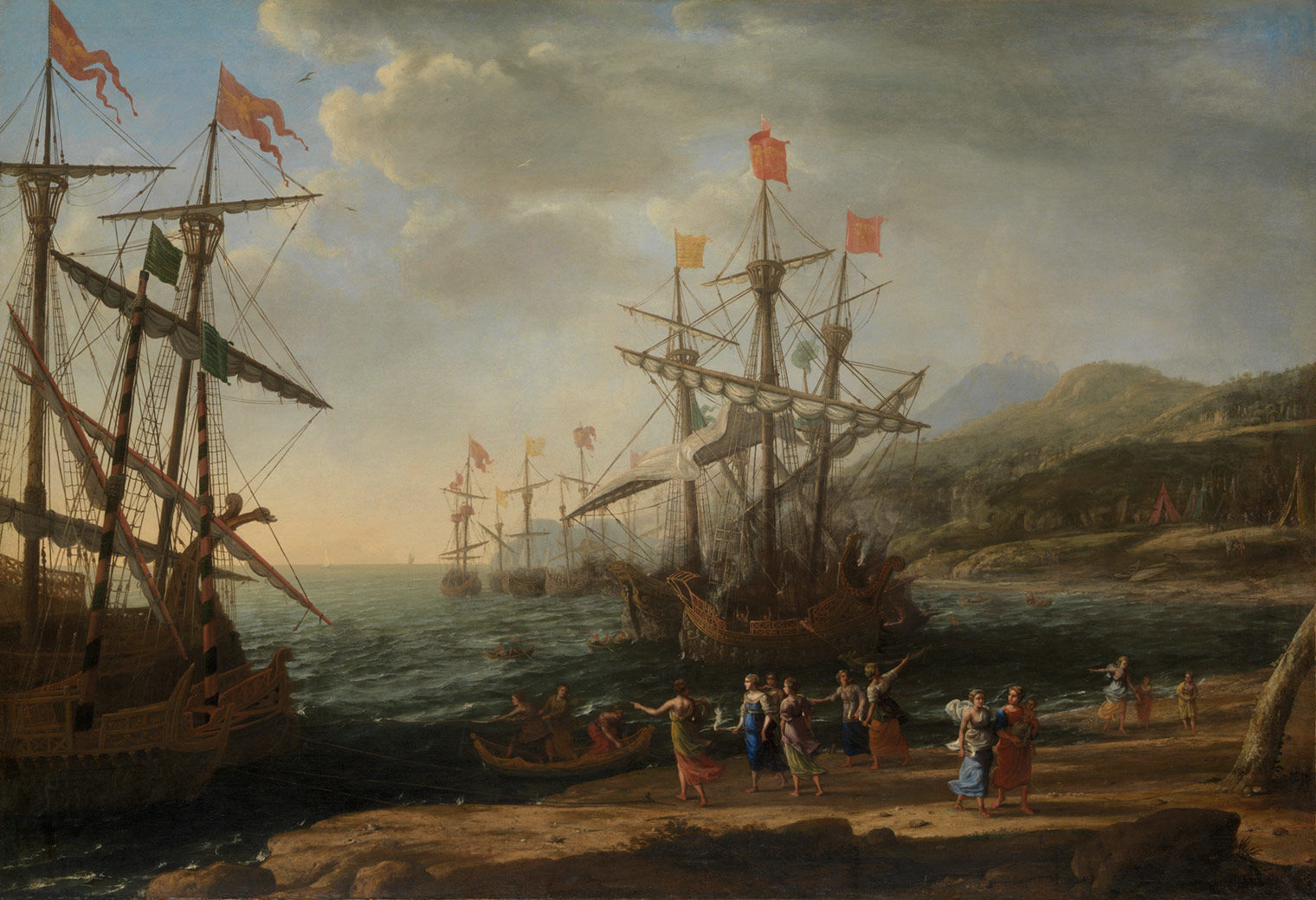Aeneas, Art, and Storytelling

Claude Lorrain (Claude Gellée) (French, 1604/5?–1682). The Trojan Women Setting Fire to Their Fleet (detail), about 1643. Oil on canvas, 41 3/8 x 59 7/8 in. (105.1 x 152.1 cm). The Metropolitan Museum of Art, New York, Fletcher Fund, 1955 (55.119)
Collection Area: European Art; European Art, Seventeenth-Century; French Art
Subject Areas: World History, English Language Arts, Visual Arts
Grades: Middle School, High School
Topics/Themes: Art and Writing
Goals
Students will be able to:
- cite evidence from nonprint sources to support claims;
- make connections between primary and secondary sources; and
- identify ways in which artists draw upon the past as a source of inspiration.
National Core Arts Standards
Visual Arts
Creating: Anchor Standard 1: Generate and conceptualize artistic ideas and work.
Creating: Anchor Standard 2: Organize and develop artistic ideas and work.
Responding: Anchor Standard 7: Perceive and analyze artistic work.
Responding: Anchor Standard 8: Interpret intent and meaning in artistic work.
Connecting: Anchor Standard 11: Relate artistic ideas and works with societal, cultural, and historical context to deepen understanding.
Common Core State Standards
English Language Arts
CCSS.ELA-Literacy.CCRA.R.1 Read closely to determine what the text says explicitly and to make logical inferences from it; cite specific textual evidence when writing or speaking to support conclusions drawn from the text.*
CCSS.ELA-Literacy.CCRA.R.7 Integrate and evaluate content presented in diverse media and formats, including visually and quantitatively, as well as in words.
CCSS.ELA-Literacy.CCRA.R.9 Analyze how two or more texts address similar themes or topics in order to build knowledge or to compare the approaches the authors take.*
CCSS.ELA-Literacy.CCRA.SL.1 Prepare for and participate effectively in a range of conversations and collaborations with diverse partners, building on others' ideas and expressing their own clearly and persuasively.
CCSS.ELA-Literacy.CCRA.SL.2 Integrate and evaluate information presented in diverse media and formats, including visually, quantitatively, and orally.
History/Social Studies
CCSS.ELA-Literacy.RH.6-8.1 Cite specific textual evidence to support analysis of primary and secondary sources
CCSS.ELA-Literacy.RH.6-8.2 Determine the central ideas or information of a primary or secondary source; provide an accurate summary of the source distinct from prior knowledge or opinions.
CCSS.ELA-Literacy.RH.6-8.6 Identify aspects of a text that reveal an author's point of view or purpose (e.g., loaded language, inclusion or avoidance of particular facts).*
CCSS.ELA-Literacy.RH.6-8.7 Integrate visual information (e.g., in charts, graphs, photographs, videos, or maps) with other information in print and digital texts.
*Art as text
Activity before Viewing
Activity Setting: Classroom
Materials: Colored pencils and paper
Subject Areas: Visual Arts, World History, English Language Arts
Duration: 20 minutes
Listen to a read-aloud of the scene describing the Trojan women burning their ships from Chapter Five in Aeneas: Virgil's Epic Retold for Younger Readers (see resources). Visualize the scene and sketch what you imagine as you listen to the text. Share your drawing with classmates and explain how you interpreted the text.
Questions for Viewing
- Take a moment to observe this painting.
- Take turns sharing one word that comes to mind when viewing the painting. Once someone mentions a word, it cannot be repeated.
- Why did you choose that word to describe the painting?
- Make a "telescope" by rolling a piece of paper into a tube. Look closely at the painting through the "telescope" and notice the small details.
- What is happening in this painting? What do you see that supports your ideas?
- Read the scene describing the Trojan women burning their ships from Chapter Five in Aeneas: Virgil's Epic Retold for Younger Readers again.
- Turn to your own sketch of this scene. How is your interpretation of the scene similar to or different from the one created by this artist?
- How has this artist interpreted the story? Why do you think the artist chose to paint this scene in this way?
Resources
"Claude Lorrain (Claude Gellée): The Trojan Women Setting Fire to Their Fleet" (55.119) In Heilbrunn Timeline of Art History. New York: The Metropolitan Museum of Art, 2000–. (February 2014)
Frankel, Emily. Aeneas: Virgil's Epic Retold for Younger Readers. London: Bristol Classical Press, 1991. See Chapter 5, "The Trojans Stop in Sicily."
Objects in the Museum's Collection Related to this Lesson
Master of the Aeneid (active about 1530–40). Aeneas Fleeing Troy with Anchises, Creusa, and Ascanias (Aeneid, Book II), probably about 1530–35. Painted enamel on copper, partly gilt; 8 3/4 x 7 3/4 in. (22.2 x 19.7 cm). The Metropolitan Museum of Art, New York, Fletcher Fund, 1945 (45.60.3)
Jean Cornu (French, 1650–1710). Venus Giving Arms to Aeneas, 1704. Terracotta and painted wood; H. 41 9/16 in. (108 cm). The Metropolitan Museum of Art, New York, The Friedsam Collection, Bequest of Michael Friedsam, 1931 (32.100.158)
Salvator Rosa (Italian, 1615–73). The Dream of Aeneas, 1660–65. Oil on canvas; 77 1/2 x 47 1/2 in. (196.9 x 120.7 cm). The Metropolitan Museum of Art, New York, Rogers Fund, 1965 (65.118)
Author: Nicole Feliciano, West Prep Academy (MS 421), 2015